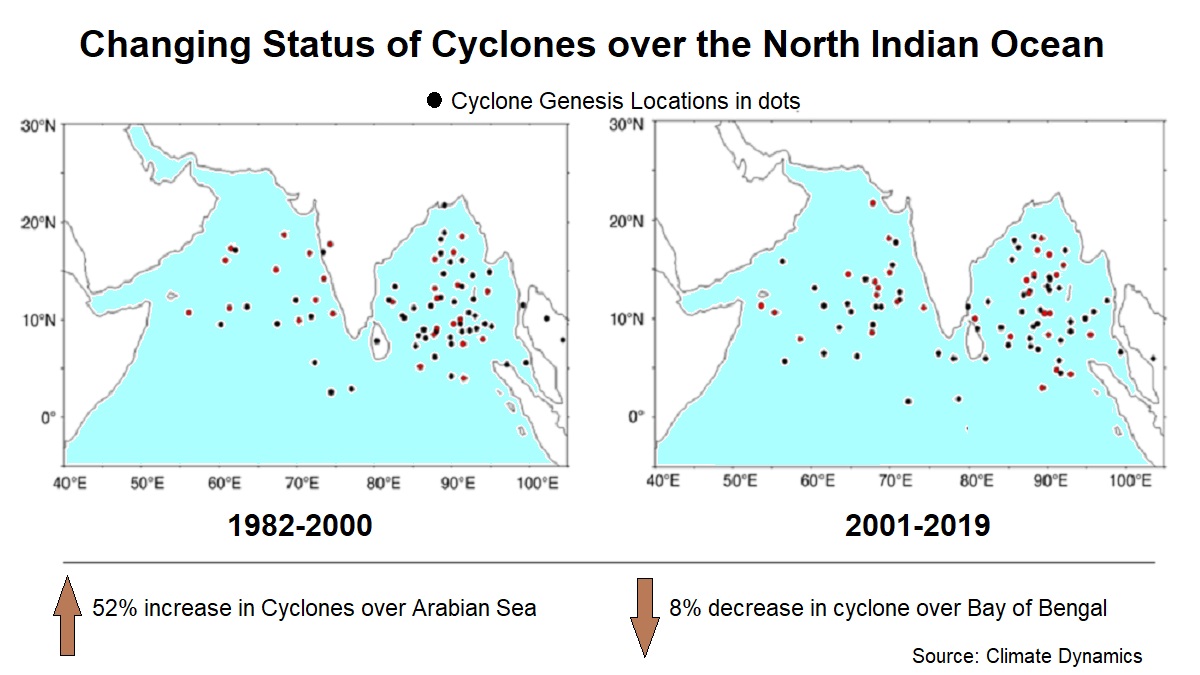Biporjoy: 150% Increase in Severe Cyclone Activity in the Arabian Sea
The spike in cyclone activity in the Arabian Sea is meticulously linked to rising ocean temperatures and increased moisture availability as an effete of global warming. The most recent example is Cyclone Mocha, which strengthened to the level of a severe cyclone, and the youngest one is the Biporjoy Cyclone, ready to pummel the Arabian Sea.
Cyclone Biporjoy has intensified even faster, progressing from a cyclonic circulation (June 5) to a Severe Cyclonic storm (June 7) in less than 48 hours (June 7). Experts stipulate that there has been an increase in the frequency of cyclones forming towards the start of the Monsoon, such as Cyclone Tauktae. Cyclo genesis has increased in the Indian Ocean as a result of reduced Monsoon circulation caused by climate change.

What Experts Say?:
Dr. Roxy Matthew Koll, the Lead Author of the IPCC and a Climate Scientist at the Indian Institute of Tropical Meteorology opines strongly: "Sea Surface Temperatures (SST) usually remain high during this time of the year. However, presently they are 2-3 degrees higher than the usual warmer temperatures. This means there is more heat and moisture in the atmosphere, which helps cyclonic storms to maintain their strength for a longer period. The threshold value for the formation of a cyclone is 26 degree Celsius, but at present SSTs are in the range of 30-32 degrees Celsius. This rise can be attributed to a rise in the ocean heat due to climate change."
Accumulated Cyclone Energy (ACE):
Accumulated Cyclone Energy (ACE) is a measure of the activity of a cyclone/hurricane season. It takes into account the number of hurricane systems, how long they persisted, and how severe they steadily increased. According to data released on rocksea.org, the cumulative cyclone energy in the Arabian Sea has nearly tripled. Accumulated cyclone energy is a measure of the overall wind energy released by a cyclone over its lifetime. The translation speed of cyclones (the speed at which cyclones move) has reduced in the Arabian Sea. This means that cyclones are moving more slowly, raising the threat quotient. As the cyclone intensifies, it glides slowly across the water. Furthermore, greater sea travel implies more moisture feed for it to sustain its strength.

According to a paper published by Dr. Medha Deshpande, Indian Institute of Tropical Meteorology, Ministry of Earth Sciences, on the evaluation of Climate Change over the Indian Region, most models predict a larger SST warming in the Arabian Sea than the Bay of Bengal. The observed surface warming over the Indian Ocean has been related to both natural and anthropogenic (man-made) factors. Climate model simulations reveal that over 90% of the trend in Sea Surface Temperature during the 1950s is highly likely attributable to rising anthropogenic emissions, with the remainder due to internal variability.
Among the human factors, the change in radiative forcing caused by increased greenhouse gas concentrations is the most significant. Radiative force is a measure of the difference between incoming solar radiation and outgoing terrestrial radiation in the Earth-atmosphere system. The severity of tropical cyclones (TC) is tightly linked to ocean Sea Surface Temperatures (SST) and heat content, with regional variances in their correlations. With sustained global warming, the activity of very severe cyclonic storms (VSCS) over the North Indian Ocean (NIO) is expected to rise in the twenty-first century.

According to the IPCC Report on Ocean, Cryosphere, and Sea Level Change, temperature at the ocean surface has gone up by 0.88 [0.68 to 1.01] °C on average between 1850-1900 and 2011-2020, with 0.60 [0.44 to 0.74] °C of this warming occurring since 1980. Between 1995 and 2014 and 2081 to 2100, the average ocean surface temperature is expected to rise by 0.86 [0.43 to 1.47, probable range] °C in SSP1-2.6 and 2.89 [2.01 to 4.07, likely range] °C in SSP5-8.5. Since the 1950s, the Indian Ocean and the western boundary current have experienced the most rapid surface warming. A warmer environment would enhance the severity of severe tropical cyclones.



 Click it and Unblock the Notifications
Click it and Unblock the Notifications




























